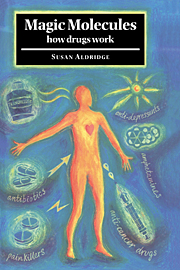Book contents
- Frontmatter
- Contents
- List of illustrations
- Acknowledgements
- Introduction
- 1 How drugs work
- 2 From penicillin to Prozac: introducing pharmaceutical drugs
- 3 Fighting infection
- 4 The hormonal revolution
- 5 Cardiovascular drugs: protecting the heart and brain
- 6 The problem of pain
- 7 The cancer challenge
- 8 Drugs for the mind
- 9 Drugs of recreation and addiction
- 10 Natural alternatives: vitamins, minerals and herbs
- 11 In the pipeline: gene-based medicine
- Bibliography
- Index
2 - From penicillin to Prozac: introducing pharmaceutical drugs
Published online by Cambridge University Press: 05 August 2012
- Frontmatter
- Contents
- List of illustrations
- Acknowledgements
- Introduction
- 1 How drugs work
- 2 From penicillin to Prozac: introducing pharmaceutical drugs
- 3 Fighting infection
- 4 The hormonal revolution
- 5 Cardiovascular drugs: protecting the heart and brain
- 6 The problem of pain
- 7 The cancer challenge
- 8 Drugs for the mind
- 9 Drugs of recreation and addiction
- 10 Natural alternatives: vitamins, minerals and herbs
- 11 In the pipeline: gene-based medicine
- Bibliography
- Index
Summary
In the UK today there are around 6000 different drugs, available either on prescription or over the counter. They range from antibiotics, anaesthetics and painkillers, to drugs that treat heart disease, cancer, ulcers, and depression.
The pharmaceutical industry has grown tremendously over the last 50 years or so; in 1934 doctors had only a thousand medicines to offer their patients. Aspirin was one of the first drugs to be manufactured, by the German company Bayer in 1899. But the industry did not really take off until the 1930s with the development of the antibiotic Prontosil, which was soon followed by the launch of penicillin and related drugs.
In the 1940s and 1950s drugs to treat conditions such as epilepsy, allergy and mental illness were discovered. Research and development continued to gather pace – and between 1970 and 1990, over 400 new drugs were introduced in the UK alone.
Drugs are big business: the pharmaceutical industry is said to be worth $256 billion per annum, and to be growing at around ten per cent a year. In the UK, for instance, pharmaceuticals had a trade surplus of £2133 million in 1995, second only to North Sea oil.
The top 20 worldwide best-sellers (Table 1) are mostly treatments for infection, heart disease and digestive system disorders such as ulcers. Of the 484 new drugs coming onto the UK market in the period from 1972–1995, the top three categories were diseases of the central nervous system (77 drugs), infection (76 drugs) and cardiovascular disease (73 drugs). But there are still many conditions, as we shall see, for which there are few or no pharmaceutical drugs.
- Type
- Chapter
- Information
- Magic MoleculesHow Drugs Work, pp. 23 - 52Publisher: Cambridge University PressPrint publication year: 1998



